ISSN ONLINE(2319-8753)PRINT(2347-6710)
ISSN ONLINE(2319-8753)PRINT(2347-6710)
D. N. Dewangan1, Dr. Y. P. Banjare2, Dr. Manoj Kumar Jha3
|
| Related article at Pubmed, Scholar Google |
Visit for more related articles at International Journal of Innovative Research in Science, Engineering and Technology
Fault diagnosis of steam turbine is essential to predict further development and to anticipate it by taking appropriate measures. Fault diagnosis of modern industrial power plants by human inspection is time-consuming and expensive as well as fault diagnostic system modelling based on conventional mathematical tools is not suitable for ill defined and uncertain system. Therefore, it is necessary to develop a knowledge-based intelligent fault diagnostic and treatment system. The primary aim of the work is developing a fast and reliable fault diagnostic and treatment system to assist plant operators. Averaging error of ANFIS is opted for fitness function of the genetic program. In this diagnosis process, the fault diagnosis and treatment model has simulated using MATLab Simulink and obtain rules set extracted by original neural network, ANFIS structure and genetically tuned dual-ANFIS. The comparative result of fault diagnosis of different method shows that the mode of genetically tuned ANFIS has higher precision in comparison to other knowledge obtaining methods.
Keywords |
| Genetic algorithm, ANFIS, Integral square error, Steam turbine, Fault diagnosis. |
INTRODUCTION |
| Due to manufacturing fault, improper installation and/or operation etc. causes unexpected and sudden production failure that can leads to economic loss and safety problems. In view of this, the past successful diagnostic cases have been recorded for the steam turbine. The past successful solutions may be considered as positive assistance in differentiating the multiple possible fault diagnoses. To explore and maximize the use of human knowledge to derive possible conclusions from inexact premises, a knowledge-based fault diagnostic system (genetically tuned ANFIS technique) based on a combination of general fault analysis, machine and operator specific experience, and computer simulation is presented in the work. |
STUDY OF VIBRATION RELATED CONDITION SYMPTOMS OF STEAM TURBINE FAULTS |
| Cayrol (1982) represented that weighted fuzzy rule base gives a good use of knowledge derived from successfully solving real problems and ranking (weights) them based on past experience. Lou et al. (2004) used an adaptive neuralfuzzy inference system based on wavelet transform for the analysis of localized defects in ball bearings. Saxena et al. (2006) suggested that bearing fault diagnosis and rectification technology based on artificial neural network (ANN) and fuzzy technology has mostly used for fault diagnosis in the real systems. Samanta et al. (2006) has suggested artificial neural network (ANN) and genetic algorithm as an effective tool for fault diagnosis of any rotating machine using time domain feature of vibration. |
| Lee et al. (2007) has used adaptive network based fuzzy inference system (ANFIS) and genetic algorithm to find out bearing fault of induction motor. Time domain and frequency domain features of vibration are used as input data for bearing fault diagnosis. In the literature, an optimal fuzzy system based on vibration database of defective and normal bearing has developed to investigate the learning process of ANFIS model and genetic algorithm has optimize the ANFIS structure using the input-output data. Salahshoor et al. (2011) has presented fault detection and diagnosis technique for an industrial steam turbine using adaptive neuro-fuzzy inference system. The pattern recognition ability of ANFIS can diagnose the steam turbine malfunctions through diverse set of possible faults that cannot be interpreted by human expert due to combinatory nature of data. These investigations shows that ANFIS has an excellent quality in extracting the information from complex and knowledge based nonlinear data sets through adaptive technique of structure and genetic algorithm is a powerful tool for optimization or search processes of the fuzzy rule base system. The major advantage of these techniques is to select the suitable configuration of fuzzy model. |
| Diagnosis may be defined as evaluating technical operating conditions based on considerable physical quantities, which are sources of diagnostic symptoms. Due to rich information and well-developed procedure for data processing and diagnostic information extraction, vibration related condition symptoms is most important for fault diagnosis of any rotating machine. In principle, a new machine with no malfunctions (assumed to be in good technical condition) is considered as the reference of condition symptoms. Bently et al. (2002) and Randall (2011) suggested that each absolute frequency component is normally influenced by some operational parameters and can expressed potential faults of steam turbine. |
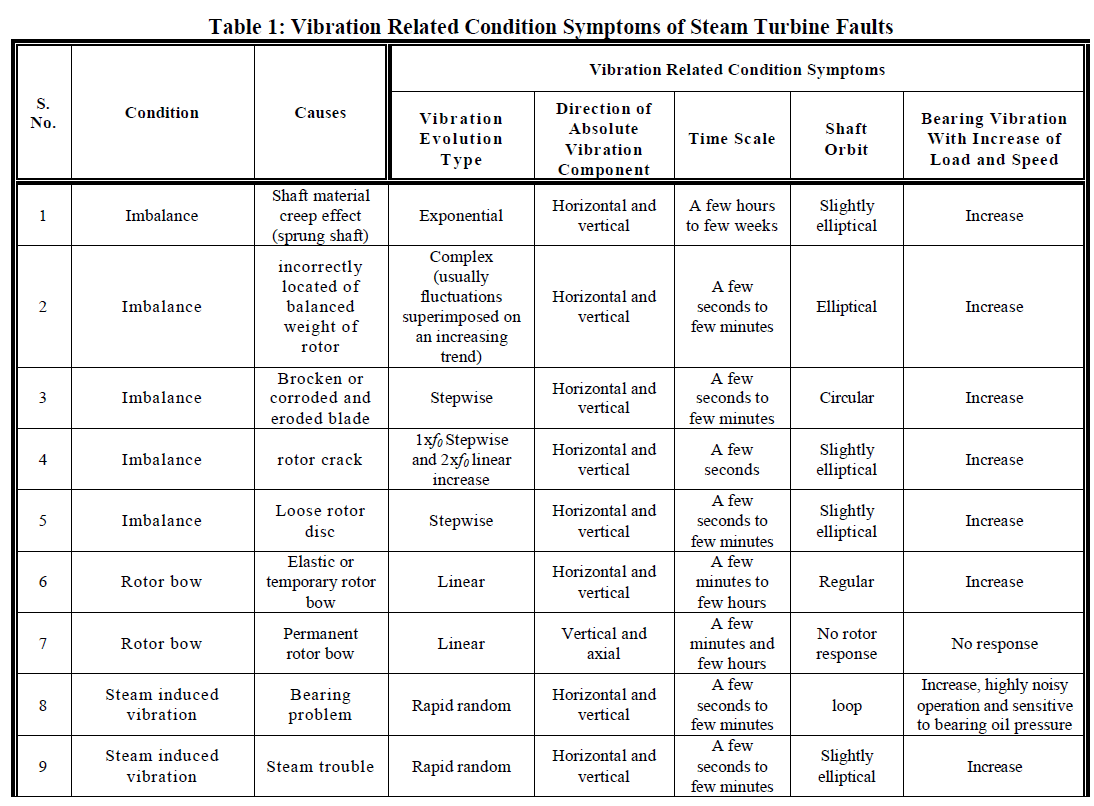 |
 |
| The vibration related condition symptom deals with absolute vibration spectral components of frequencies, which is determined by f = nf0, where f0 is the fundamental frequency caused by rotational speed and relative vibration orbits. Herein, first four harmonic (n ≤ 3) and sub-harmonic (n < 1) components has taken into consideration to diagnose the steam turbine mechanical faults. In malfunctions related to steam turbine applications, absolute vibration spectral components corresponding to n > 4 are rarely accounted [Bently and Hatch, 2002 and Randall, 2011]. The typical malfunctions of harmonic and sub-harmonic frequency ranges and their corresponding symptoms have been listed in table 1. This work is based on qualitative diagnosis focussed on some mechanical faults associated to steam turbine, neglecting the interference and considering vibration related condition symptom, such as absolute vibration spectra, direction of vibration propagation, time scale evaluation of spectral component, shaft orbit and bearing vibration with increase of load and speed. |
GENETICALLY TUNED DUAL-ANFIS MODEL DEVELOPMENT FOR FAULT DIAGNOSIS AND TREATMENT |
| To explore the optimum use of human knowledge and derive possible conclusions from inexact premises, a knowledgebased genetically tuned ANFIS model is developed based on a combination of general fault analysis, machine and operator specific experience, and computer simulation. The basic steps taken in the behavioural modelling process of genetically tuned dual-ANFIS model are as follows: |
| Step 1: Formation of potential diagnostic and treatment rule conditions: To maximize the use of human knowledge, past successful diagnostic cases have recorded and past successful solutions may be considered as positive assistance in differentiating the multiple possible fault causes and their remedies. The sources of diagnostic rules for qualitative diagnosis of mechanical faults are based on the considered vibration related condition symptoms of steam turbine. The potential diagnostic rule conditions are focused on absolute vibration components, vibration evolution type, direction of absolute vibration component propagation, time scale evaluation of spectral component, shaft orbit and bearing vibration condition with increase of load and speed as given in table 2. |
| Step 2: Development and training of Dual-ANFIS system: Adaptive network based fuzzy inference system (ANFIS) is mostly used to automate the knowledge acquired by human experts to controlling the system [Hoffmann, 2001]. The adaptive nature of ANFIS is used for optimization of the input membership functions (premise parameters) and the output membership function (consequent parameters). |
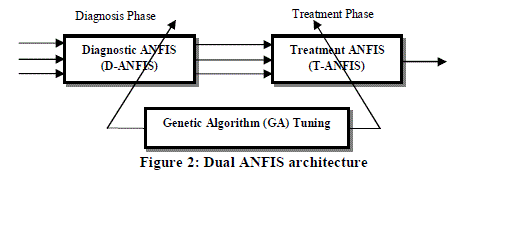 |
| The dual-ANFIS model of steam turbine fault diagnosis consists of Diagnostic-ANFIS (D-ANFIS) and Treatment- ANFIS (T-ANFIS). The dual-ANFIS model is characterized by the set of symptom-cause diagnostic rules. The diagnostic and treatment rules are as follows: |
| If Symptom is A then Cause is B : Diagnostic-ANFIS |
| If Cause is B then Remedy is C : Treatment-ANFIS |
| In this model, T-ANFIS is used in series combination with D-ANFIS as shown in figure 2. Diagnosis-ANFIS take care of the diagnostic rules extraction and T-ANFIS deals with the treatment rules extraction. The training error gives justification of the optimization of developed ANFIS system. |
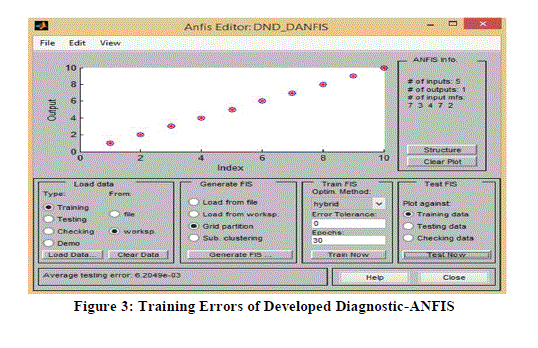 |
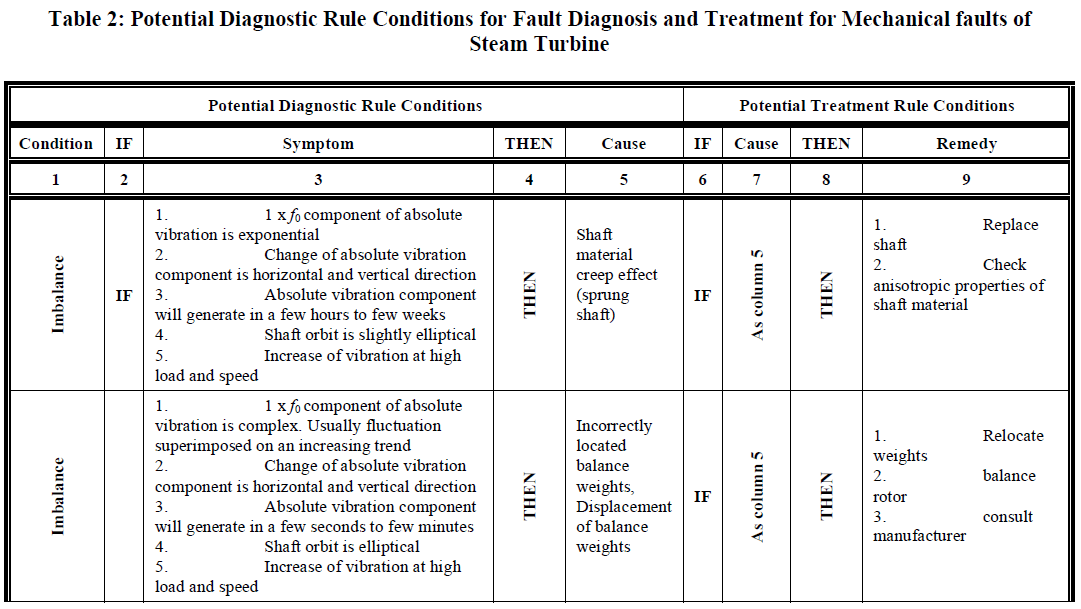 ' ' |
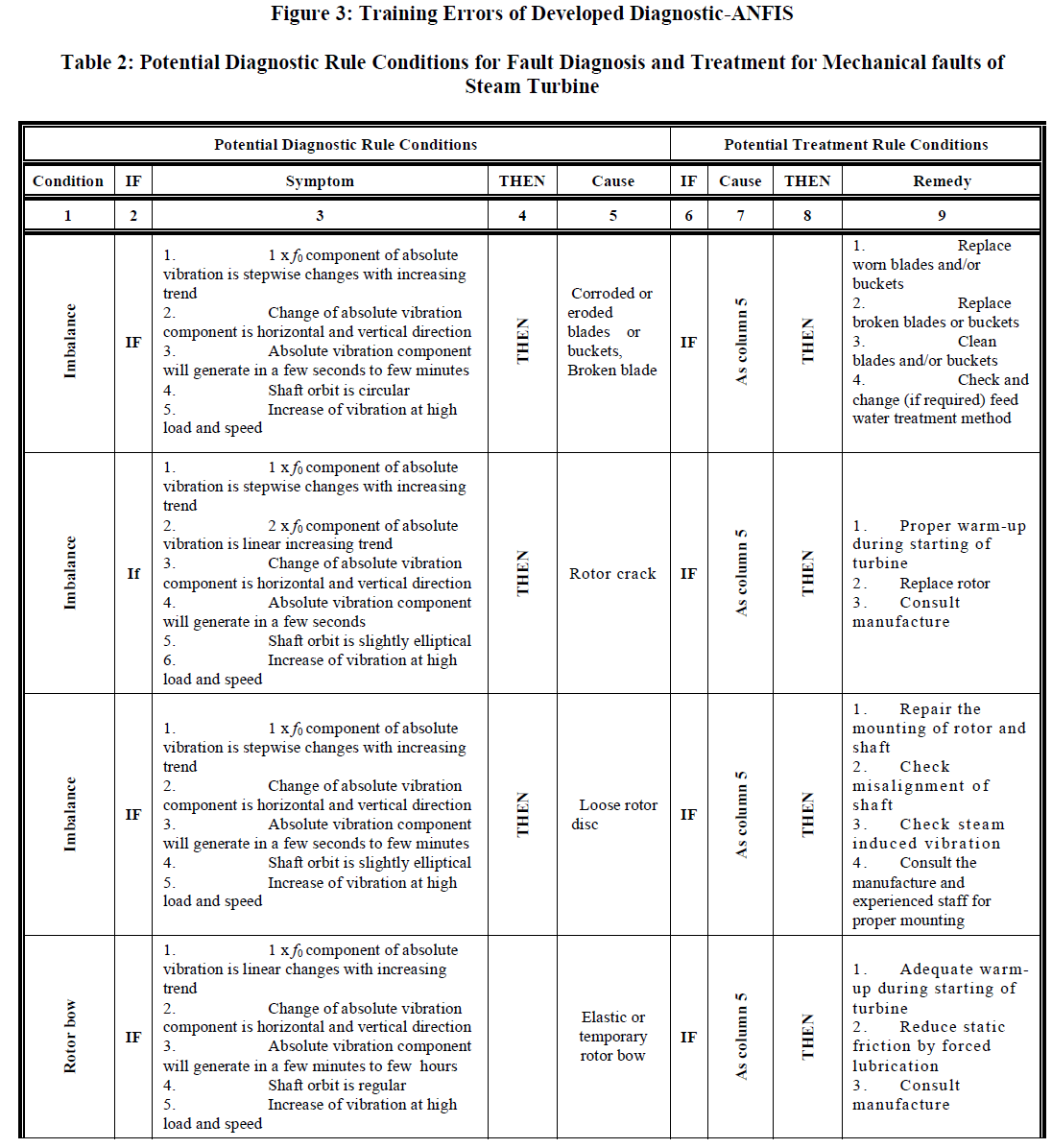 |
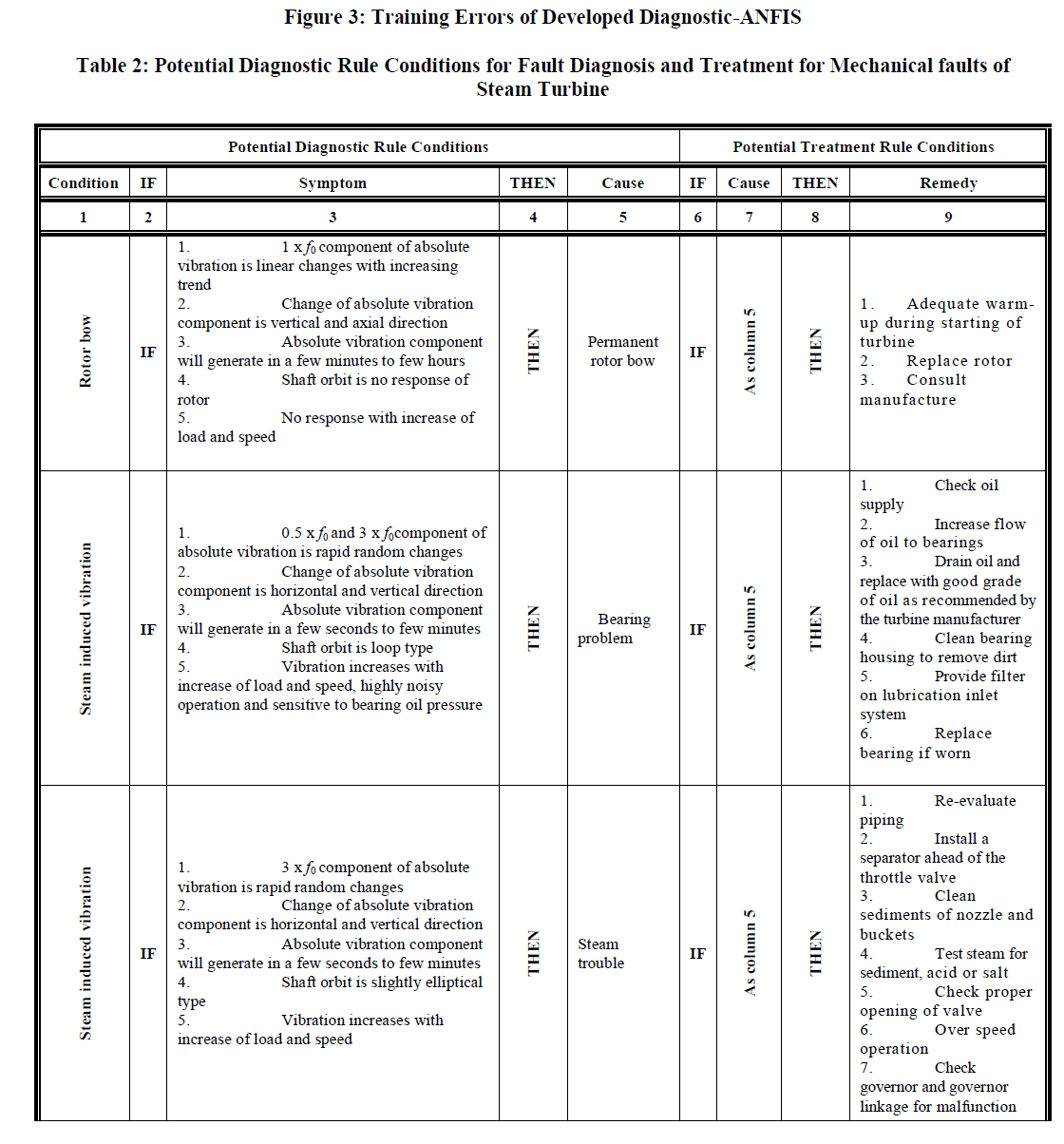 |
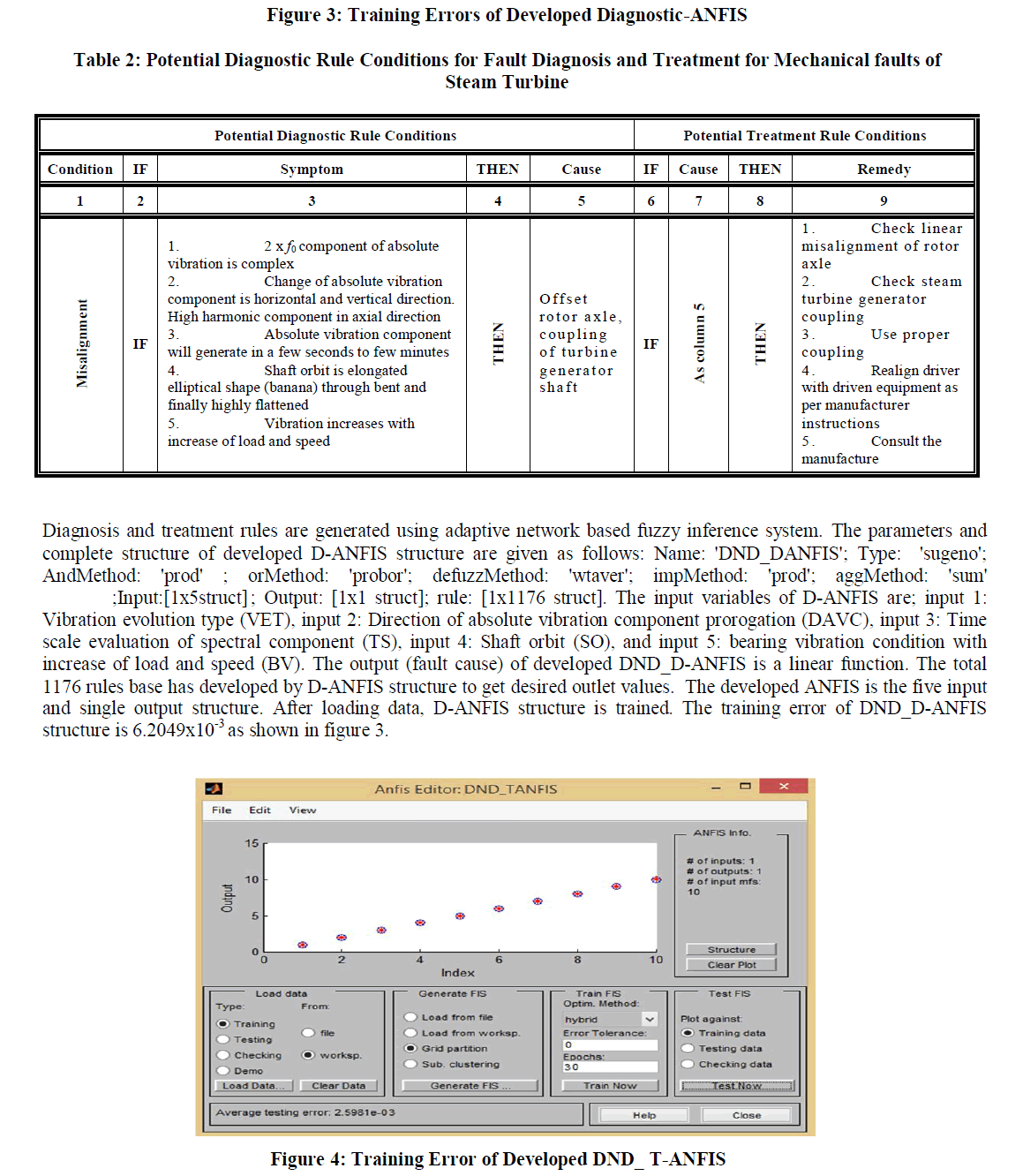 |
| The parameters and complete structure of developed T-ANFIS structure are given as follows: Name: 'DND_T-ANFIS'; Type: 'sugeno'; AndMethod: 'prod'; orMethod: 'probor'; defuzzMethod: 'wtaver'; impMethod: 'prod'; aggMethod: 'sum'; Input: [1x1 struct]; Output: [1x1 struct]; Rule: [1x10 struct]. The developed DND_TANFIS is the single input (fault cause) and single output (remedy) structure. After loading data, T-ANFIS structure is trained. The training error of DND_T-ANFIS structure is 2.5981x10-3. Figure 4 shows the training error of Treatment-ANFIS structure. The output of developed DND_T-ANFIS is a linear function. The total 10 rule bases have developed by T-ANFIS structure to get desired outlet values. |
| Step 3: Optimization of Dual-ANFIS Structure using Genetic Algorithm: Genetic algorithm is a powerful tool for optimization or search processes of the fuzzy rule base system, since it has applied to find out the solution by simulating the evolutionary process of survival of the fittest so that best member of population will retain. The evolutionary process continues until the best solution is generated. The major advantage of these techniques is to minimizing the modelling error by tuning and/or learning fuzzy rule base and obtains the efficient configuration of ANFIS model for reliable fault diagnosis of steam turbine. Thus, genetically tuned ANFIS structure combines the features of the fuzzy rule-based system, interpolative reasoning, and the evolutionary algorithms and has an excellent quality in extracting the information from complex and knowledge based nonlinear data sets through adaptive technique of ANFIS structure. Genetically tuned ANFIS model provides a much closer behavioural model of the steam turbine to the real system [Dewangan et al., 2014]. Therefore, a genetically tuned ANFIS technique has suggested in the work to minimize the modelling error and thus obtain the most efficient configuration of ANFIS structure that can optimize the use of vibration related condition symptoms to develop a knowledge-based fault diagnostic and treatment system. |
| The developed DND_D-ANFIS model has further tuned using genetic algorithm; a new ANFIS structure has obtained and extracting same 1176 rules with different firing strength (weights). The new tuned D-ANFIS provides the error of 2.1261× 10-5 between input and corresponding target output. Similarly, developed DND_T-ANFIS model has further tuned using genetic algorithm. After successful tuning of DND_T-ANFIS; the new tuned treatment-ANFIS provides the error 7.5433× 10-5 between input and corresponding target output. Therefore, the genetic algorithm based tuning of D-ANFIS and T-ANFIS provides much higher reduction in the error between input and target output as compare to conventional ANFIS. |
RELIABILITY ESTIMATION OF DIAGNOSIS AND TREATMENT PROCESS |
| After development of genetically tuned dual ANFIS model of knowledge based fault diagnosis and treatment system. The flow chart for fault diagnosis and treatment system based on the vibration related condition symptoms is given in figure 1. |
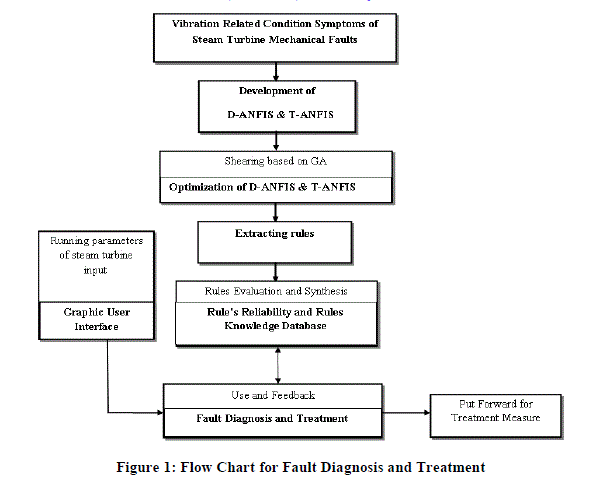 |
| For reliability estimation of presented genetically tuned model, a graphic user interface (GUI) has developed for proposed work using the flow chart for fault diagnosis and treatment system based on the vibration related condition symptoms as shown in figure 1, a graphic user interface (GUI) has developed for proposed work. For reliability estimation of presented genetically tuned model, the complete graphic user interface (GUI) developed for proposed work is shown in figure 6. |
| Suppose imbalance malfunction due to incorrectly located balance weight or displacement of balance weight is considered for fault diagnosis. Let there is a rule: |
| Diagnosis rule: If 1xf0 component of absolute vibration is complex, usually fluctuation superimposed on an increasing trend, change of absolute vibration component is horizontal and vertical direction, absolute vibration component will generate in a few seconds to few minutes, shaft orbit is elliptical, and an increase of vibration at high load and speed Then imbalance due to incorrectly located balanced weight of rotor or due to displacement of balance weight (0.87) OR If 1xf0 component of absolute vibration is not complex or change of absolute vibration component is not in horizontal and vertical direction or absolute vibration component will not generate in a few seconds to few minutes or shaft orbit is not elliptical, and an decrease of vibration at high load and speed Then imbalance due to incorrectly located balanced weight of rotor or due to displacement of balance weight (0.13). |
| Rectification rule: If imbalance due incorrectly located of balanced weight of rotor or due to displacement of balance weight Then relocate weights and/or balance rotor and consult manufacture (0.86) OR If imbalance due to incorrectly located balanced weight of rotor or due to displacement of balance weight Then don’t relocate weights or don’t balance rotor and don’t consult manufacturer (0.14); The weight or degree of the rules condition is supported by its firing strength (weight) given in the bracket for the conclusion. There are the facts of the imbalance malfunction due to incorrectly located balance weight or displacement of balance weight, acquired from industry fault data base are given as below: |
| (1) Imbalance due incorrectly located of balanced weight of rotor or due to displacement of balance weight caused by 1xf0 component of absolute vibration is complex and usually fluctuation superimposed on an increasing trend and change of absolute vibration component is horizontal and vertical direction and absolute vibration component will generate in a few seconds to few minutes and shaft orbit is elliptical and an increase of vibration at high load and speed (0.89); |
| (2) Relocate weights and/or balance rotor and consult manufacture can solved the problem of imbalance due to incorrectly located of balanced weight of rotor or displacement of balance weight (0.60); |
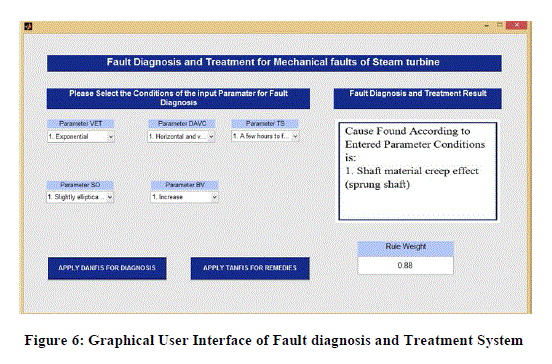 |
| (A) FIDELITY OF FAULT DIAGNOSIS AND TREATMENT PROCESS: |
| This section deals degree of reliability for fault forecasting and diagnosis process of steam turbine mechanical faults. Maniezzo, (2006) and Geo et al., (2008) suggested a method to check the fidelity of diagnosis process. In the first step, the process of diagnosis is finding the recognized frames of the faults of steam turbine. |
| Let X= {P1, P2, P3} = THEN part problems |
| Here, P1 denotes the fault causes, for considered case “imbalance due incorrectly located of balanced weight of rotor or due to displacement of balance weight”. P2 denotes reverse of P1. For considered case P2 denotes “Not imbalance due incorrectly located of balanced weight of rotor or displacement of balance weight” and P3 denotes “there are the above two problems have developed at the same moment”. Then, the probability distributes function for P1, P2, and P3 has obtained as following: |
| Diagnosis rule: If 1xf0 component of absolute vibration is complex, usually fluctuation superimposed on an increasing trend, change of absolute vibration component is horizontal and vertical direction, absolute vibration component will generate in a few seconds to few minutes, shaft orbit is elliptical, and an increase of vibration at high load and speed, then the degree of reliability of the rule’s condition supported for conclusion is (Wrule) = 0.87, and knowledge based degree of reliability of the rule’s fact (Wfact) = 0.86. Therefore the probability distribution function for P1 is given by m1 ({P1}) = degree of reliability of rule’s fact (Wfact) × degree of reliability of rule’s conclusion (Wrule) = 0.86 × 0.87 = 0.748 |
| While, Degree of reliability of the rule’s condition supported for conclusion for P2 is (Wrule) = 0.13, and knowledge based degree of reliability of the rule’s fact (Wfact) = 0.86. The probability distribution function for P2 is given by: m1 ({P2}) = the degree of reliability of rule’s fact (Wfact) × the degree of reliability of rule’s conclusion (Wrule) = 0.86 × 0.13= 0.112. |
| m1 ({P1, P2, P3}) =1- m1 ({P1}) - m1 ({P2}) =1- 0.748- 0.112 = 0.140 |
| Rectification rule: degree of reliability of the rule’s condition supported for conclusion (Wrule) = 0.86, and knowledge based degree of reliability of the rule’s fact (Wfact) = 0.60. Therefore the probability distribution function for treatment are given by |
| m2 ({P1}) = 0.60× 0.86 = 0.516, |
| m2 ({P2}) =0.60× 0.14 = 0.084 |
| m2 ({P1, P2, P3}) = 1- m2 ({P1}) - m2 ({P2}) =1- 0.516 - 0.084 = 0.400 |
| Combine the two probability distributes function: |
| K=1 / {1-[m1 ({P1}) x m2 ({P2}) + m1 ({P2}) x m2 ({P1})]} |
| = 1 / {1- [0.748 × 0.084 + 0.112 × 0.516]} = 1.137 |
| Therefore, degree of probability of P1: |
| m ({P1}) = K [m1 ({P1}) m2 ({P1}) + m1 ({P1}) m2 ({P1,P2,P3}) + m1 ({P1, P2, P3}) m2 ({P1})] = 1.137[0.748 x0.516 + 0.748x 0.40 + 0.140 x 0.516] = 0.861 |
| And, degree of probability of P2: |
| m ({P2)} = K [ m1 ({P2}) m2 ({P2}) + m1 ({P2}) m2 ({P1, P2, P3}) + m1 ({P1, P2, P3}) m2 ({P2)}] = 1.137[0.112 x 0.084 + 0.112 x 0.40 + 0.140 x 0.084] = 0.075 |
| m ({P1, P2, P3}) =1- m({P1}) – m ({P2}) = 1- 0.861-0.075= 0.064 |
| Therefore, the degree of the reliability from the reliability function is given by: |
| Degree of reliability of P1 = m ({P1}) = 0.861 |
| Degree of reliability of P2 =m ({P2}) = 0.075 |
| (B) Diagnosis Conclusion: |
| From steam turbine fault diagnosis process, we find that the degree of the reliability of the truth of P1“imbalance due incorrectly located of balanced weight of rotor or due to displacement of balance weight” is 0.861, and the nonfalse of that is 0.925 (1-0.075). The degree of the reliability of the truth of P2 (P2 is the reverse of P1) is 0.075, and the non-false of that is 0.139 (1- 0.861). Thus, it can be concluded that the rule conditions mentioned for considered case are true. In this diagnosis process, the fault diagnosis and treatment model has simulated and obtain rules set extracted by original neural network, rules set extracted from the ANFIS structure and rules set extracted from genetically tuned dual-ANFIS. Similarly, reliability of other potential rule sets have determined and the average value of simulation results are listed in table 7.4 for the comparison. The comparative result of fault diagnosis of different method shows that the mode of genetically tuned ANFIS has higher precision. The genetically tuned ANFIS model has good ability of generalization and noise tolerance. |
 |
| To estimate the practical reliability of developed genetically tuned dual-ANFIS structure, 50 past diagnosis cases of different unit (each of 500 MW) of power plant has considered. Among the 50 diagnosis cases 43 cases have diagnosed exactly. Thus the precision of the developed genetically tuned dual-ANFIS is 86%, but neural network based model has precision 77% and dual ANFIS without using genetic algorithm has 82%. Therefore, using genetic algorithm for obtaining the optimal configuration of the ANFIS model based on the given training data is a powerful method. Thus, it can be concluded that the developed genetically tuned dual ANFIS model for fault diagnosis and treatment of steam turbine is a one of the best method in field of knowledge based fault diagnosis system. |
CONCLUSION |
| This work presents the genetically tuned dual-ANFIS model based on vibration related condition symptoms for fault diagnosis and treatment of steam turbine. Genetically tuned ANFIS are simple and has better performance compared to traditional knowledge obtaining methods and traditional neural network. Parameters and structure of the fuzzy model can be obtained on the basis of ANFIS and genetic algorithm. Averaging error of ANFIS is opted for fitness function of the genetic program and the model can obtain a local optimal design with each selected training epochs. In this diagnosis process, the fault diagnosis and treatment model has simulated and obtain rules set extracted by original neural network, rules set extracted from the ANFIS structure and rules set extracted from genetically tuned dual- ANFIS. The comparative result of fault diagnosis of different method shows that the mode of genetically tuned ANFIS has higher precision in comparison to other knowledge obtaining methods. To get better predictions of steam turbine fault, training data have collected from different types and levels of steam turbine conditions. A rich and reliable database can upgrade liability of the proposed model. |
References |
|